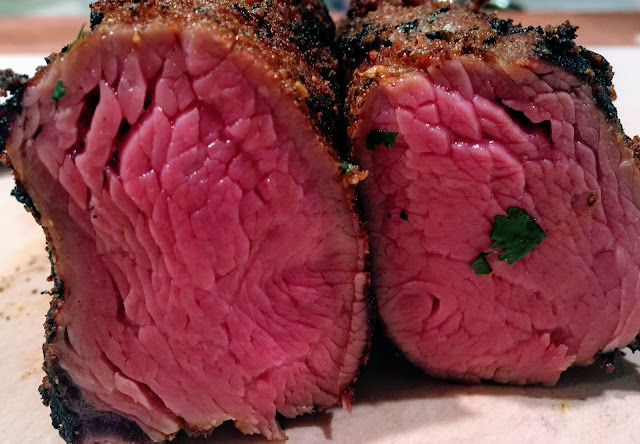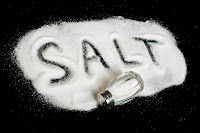Bistro Fillet aka Teres Major Steak

(OP-5/2015) So the other day, when I was making my rounds, which just means I was shopping for dinner. On my days off, I treat these outings like a tryst because my schedule is crazy, and time off is limited. One of my favorite places to go while out is the local butcher's shop, and man am I happy I stopped by. While there, I came across this rare steak (unique to me anyhow). In the Meat display, they had this steak labeled as "Western Sizzlers Steak"..... yea, no kidding. I've never heard of this cut.
I know from state to state, and from butcher to butcher, several names describe the same cut of meat. Heck, the butchers are just trying to sell meat right; who doesn't get that. If you ask me, their labeling styles have more to do with selling and marketing than anything else. It's worth mentioning that other countries have their own names too. There's no rule book on naming cuts of meat. As an example, New York Steak has many different names. In New York City, this same cut is referred to as a Club, and in the UK, it's called a Sirloin. There are several more names too. Check out the Alternate Steak Names reference guide.
The Butcher told me it came off the shoulder, and it was very tender. To say I skeptical was an understatement. After posting a few pictures on Facebook and in some of the food groups, I belong to someone kind enough to identify the steak as a petite tender. So I googled petite tender and low and behold there it was. Of course, it goes by many different names. What I found was restaurants call it a Bistro Fillet no doubt to make it sound more elegant and fancy. Heck, if it seems fancy, it must be good, and they can charge you more. When I think of Bistro, I feel fancy, and when I hear fillet, I think tender.
So what the hell is a Bistro Fillet? Up until a few days ago, I didn't know either. This cut has many aliases, so I have no doubt I have eaten this steak before at some point in my life. I'm sure the steak had some foo-foo food name and came with a hefty $$$ too.
Anyhow, I thought I would give my 15 cents on how to cook this thing. Cooking it beyond medium-rare would make this thing chewy, so I am told. Similar to a Hanger Steak. If you don't like Medium Rare steaks or Rare steaks, don't waste your money on this baby.
First things first... Trim off any excess silver skin and any excessive fat. Now onto the dry brine. I'm a big fan of dry-brining protein, although not necessary, is undoubtedly a great option.
Dry-brining denatures the proteins stands relaxing them, making the meat more tender and helps with moisture retention. Ahhh...Moisture retention? Maybe...it depends on how long you dry-brine. For details, take a look at some of the links I have provided. If you use Fish Salt or Fish Sauce, you get the benefit of dry-brining and Faux Aging. Here's a link to some of my experiments. Anyhow, I used .60% Fish Salt, knowing that after the dry-brining process, I would add just a touch more salt and other seasonings. If I were to use Fish Salt only, I would have used 1%. If I were using plain salt (prefer Kosher), I would have used probably .60% salt. So what is 1% salt added to a steak? If the steak weighed exactly 1 lb or 453.592 grams, I would multiply 1% or .01 by 453.592, which = 4.53 grams of Salt. So how long do you Dry-Brine? 6-40 hours will suffice.
Vacuum Sealed and place in the refrigerator for X amount of time. My schedule only allowed for 36 hours.
Here's a pic of the Sous-Vide Bistro Fillets. The name alone gets me excited...👀 I decided to go with 133f because this seems to work great for my Flank Steak and my Flatirons. Since this came off the shoulder, this made sense to me. For my New-Yorks, I prefer 128f; for Tenderloin Fillets, I like 124f, Ribeye 133f, and a Chuck Steak around 135f. The steaks were Warm Aged, which is my procedure for anything bovine. I set the circulator at 104f and submerged the steaks for precisely 2 hours. After the elapsed time, I turned up the temp to 133f for another 2 hours. They were shocked and refrigerated. The advantage of SV-Process food is the option of preparing them in advance.
 |
| SEASONING |
Release from the Vac bag and dried thoroughly. In fact, it's not a bad idea to place the steaks back in the refrigerator on a wired rack to dry off. I set a small fan next to them to speed up the drying. Another technique is to dust them with some AP flour to absorb some of the moisture. It's hard to sear a hunk of meat when it's wet. Wet meat will not brown very well. If you think about it for a moment as soon as the meat hits the skillet, the remaining moisture evaporates, delaying the browning and possibly bringing the internal temp higher than you had initially desired. Coat with more seasoning and get ready to sear them.
 |
| SEARING |
You have to use a hot skillet or a grill set to "HELL" to sear them. My Weber Genesis with a sear burner can get to 740f.
I've been using my De Buyer Skillets to sear off steaks, which are made of 99% iron. These pans are great. The searing procedure should only take about 2 minutes.
 |
| Balsamic Reduction |
Review- Simply amazing!! I won't change a thing. Incredibly tender and tasty. Unlike the Tenderloin, this steak has flavor.
 |
| 10 to a package... need to trim them |
UPDATE 8/19/2017 - Warm Aged at 104 f for 2 hours and finished at 128 f for 3 hrs and 45 (knowing that it takes about 15 minutes to come up to 128 f from 104 f). They were picture-perfect and tasted excellent. They felt different on the tooth textually compared with 133 f. I like both temps. At the 128 f, you have to slice them a little thinner to get a better mouthfeel.
Update 6/29/2018 - Warm Aged at 113 f for 3-hours and finished at 129 f for 4-hours. At the end of the day, both versions were excellent!!!
Update 6/29/2018 - Warm Aged at 113 f for 3-hours and finished at 129 f for 4-hours. At the end of the day, both versions were excellent!!!























Comments
Post a Comment